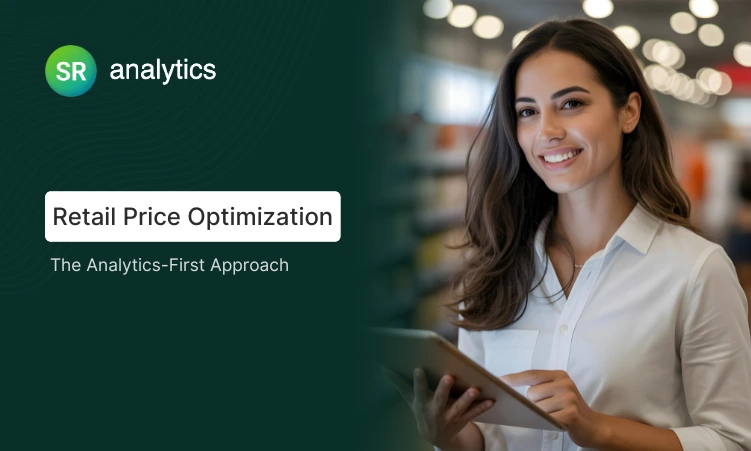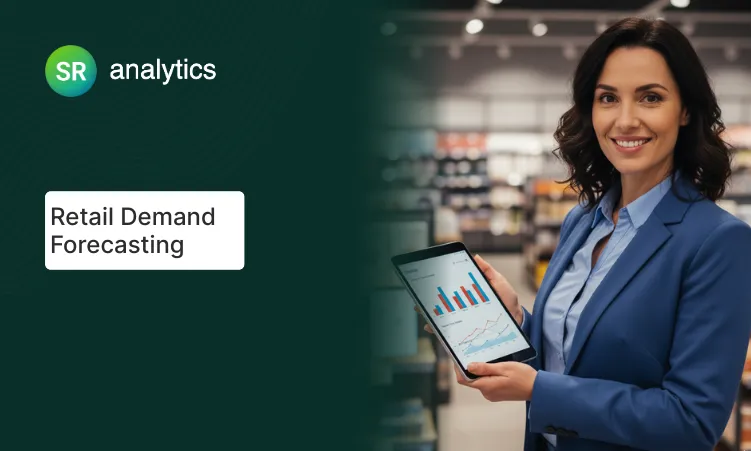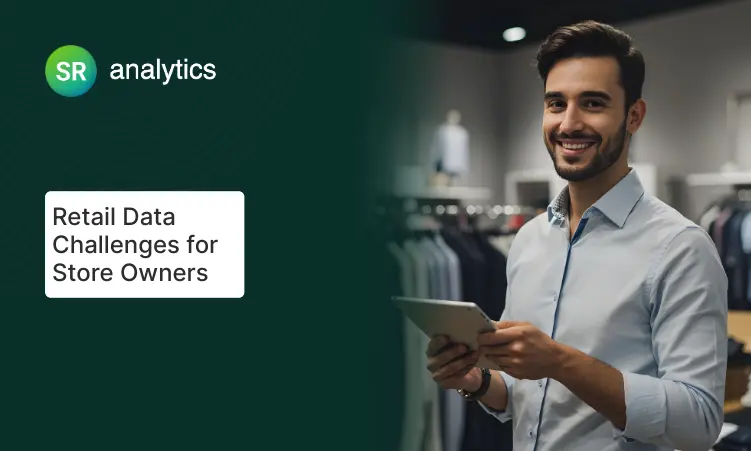Highlights
89% of retailers now use or test AI — 87% saw revenue gains
Predictive analytics cuts stockouts by 35%, excess inventory by 28%
AI-powered analytics deliver 115% higher ROI than traditional methods
Amazon drives 35% of revenue through AI-powered recommendations
Retail’s future: real-time personalization, generative AI, edge computing
Small retailers can start with inventory forecasting or email personalization
Introduction
A customer walks into your store, and within seconds, your AI system recognizes their shopping patterns and sends a personalized discount to their phone for items they’ve been eyeing online. Meanwhile, your inventory system has already predicted next week’s demand and automatically placed orders to prevent stockouts.
This isn’t science fiction—it’s happening right now in retail stores worldwide.
The retail industry is experiencing a fundamental shift. AI in retail industry applications have moved from experimental to essential, with 89% of retailers now using or testing AI in their operations. Even more telling? 87% report that AI has boosted their annual revenue.
For retailers, the message is clear: embracing AI and retail data analytics isn’t just about staying competitive—it’s about survival. Companies leveraging data-driven decision making are 23 times more likely to acquire customers and see measurable improvements in operational efficiency.
In this guide, we’ll explore how AI is transforming retail operations, from creating personalized customer experiences to optimizing complex supply chains. You’ll discover practical strategies, real-world examples, and actionable insights that can help your retail business thrive in an AI-powered marketplace.
Why AI in Retail Matters More Than Ever
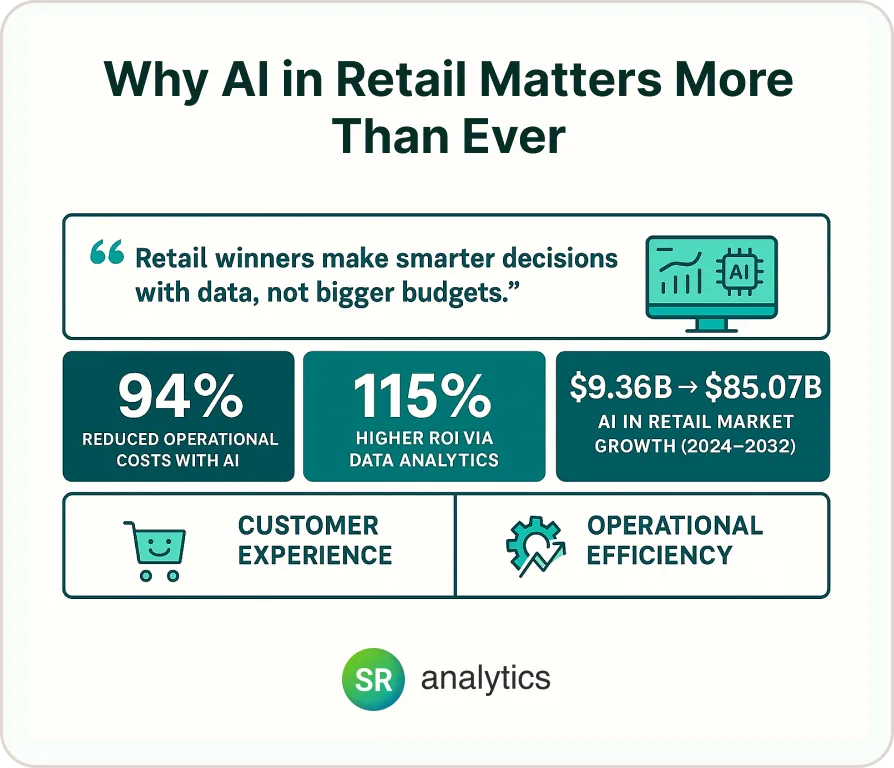
Here’s what I’ve learned from working with retail clients: the companies thriving today aren’t necessarily the ones with the biggest budgets. They’re the ones making smarter decisions with their data.
Retail data analytics powered by AI helps businesses turn overwhelming amounts of information into clear actions. Think about it—every transaction, every click, every customer interaction generates data. But raw data sitting in spreadsheets doesn’t drive growth. AI does.
The numbers tell a compelling story:
- 94% of retailers say AI has helped reduce operational costs
- Companies using data analytics report 115% higher ROI
- The AI in retail market is projected to grow from $9.36B in 2024 to $85.07B by 2032
But here’s the thing—AI isn’t just about technology. It’s about creating better experiences for customers while making operations more efficient. That’s where predictive analytics in retail becomes game-changing, helping businesses shift from reactive to proactive decision-making.
Real Impact: What AI-Driven Retailers Are Achieving
I’ve seen firsthand how retail analytics transforms businesses. One client, similar to cases in our retail success stories, improved their conversion rates by 10% in just four months by implementing comprehensive data dashboards that unified customer insights across all touchpoints.
The key? They didn’t try to implement everything at once. They started with understanding their customer journey through proper data visualization and built from there.
Creating Personalized Shopping Experiences That Actually Work
AI-Powered Personalization That Goes Beyond “Customers Who Bought This Also Bought”
Real personalization isn’t about showing random product recommendations. It’s about understanding customer behavior patterns and predicting what they’ll want next.
Retail predictive analytics creates genuine personalization through several key approaches:
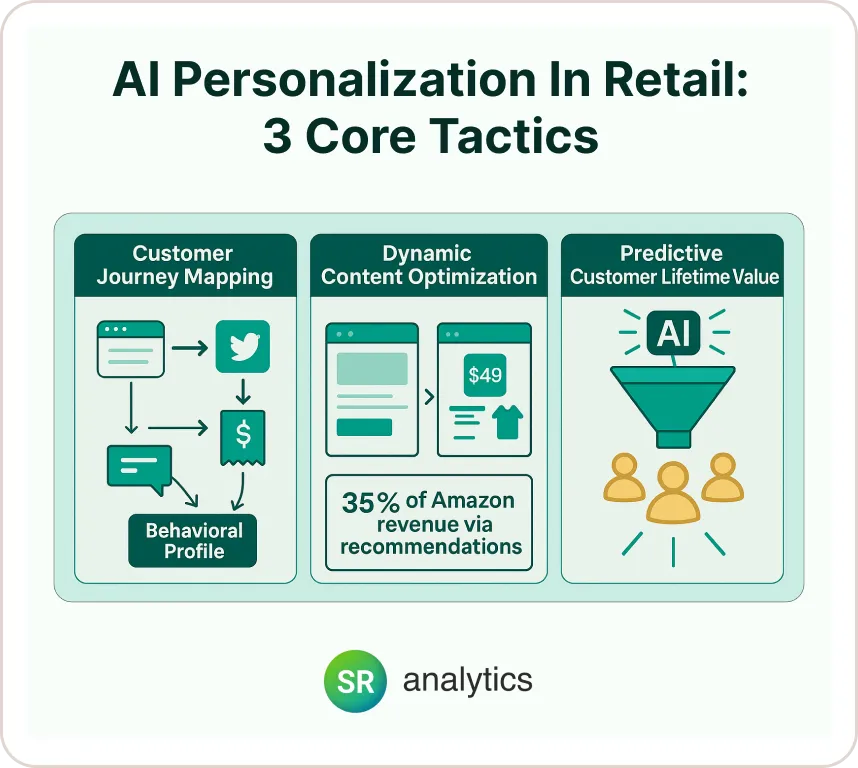
Customer Journey Mapping: AI analyzes every touchpoint—website visits, social media interactions, purchase history, even the time of day customers typically shop. This creates detailed behavioral profiles that go far beyond basic demographics.
Dynamic Content Optimization: Instead of static websites, AI continuously adjusts product displays, pricing, and promotions based on individual customer preferences. Amazon’s recommendation engine reportedly drives 35% of their revenue using this approach.
Predictive Customer Lifetime Value: AI identifies your most valuable customers before they become valuable. This helps you invest marketing dollars where they’ll have the biggest impact.
Real-World Success: How Starbucks Uses AI for Loyalty
Starbucks built their entire loyalty program around AI-powered personalization. Their app analyzes purchase history, location data, and even weather patterns to suggest drinks and food items. The result? Starbucks loyalty members spend 2.5 times more than regular customers, and the program has over 24 million active users.
The lesson? Personalization works when it’s genuinely helpful, not just clever. It requires the same kind of comprehensive business intelligence strategy that successful retailers use to unify customer data across all channels.
Predictive Analytics in Retail: From Reactive to Proactive
Demand Forecasting That Actually Predicts Demand
Traditional forecasting looks at last year’s sales and hopes for the best. Predictive analytics in retail considers hundreds of variables: weather patterns, social media sentiment, economic indicators, local events, even competitor actions.
I worked with a sporting goods retailer who was constantly dealing with stockouts during peak seasons. After implementing AI-driven demand forecasting—similar to the approach outlined in our data analytics consulting guide—they reduced stockouts by 35% while decreasing excess inventory by 28%.
The key was understanding that demand isn’t just about historical patterns—it’s about predicting how multiple factors interact in real-time.
Supply Chain Optimization Beyond Just-in-Time
Retail analytics powered by AI transforms supply chain management from a reactive process to a predictive one. Here’s what this looks like in practice:
Automated Reordering: AI systems monitor inventory levels in real-time and automatically place orders based on predicted demand, not just current stock levels.
Route Optimization: Machine learning analyzes traffic patterns, weather conditions, and delivery windows to optimize logistics routes, reducing costs and improving delivery times.
Supplier Performance Prediction: AI can predict which suppliers are likely to have delays or quality issues, allowing retailers to proactively adjust their supply chain strategies.
Case Study: How Zara Uses AI for Fast Fashion
Zara’s success isn’t just about fast fashion—it’s about fast data. Their AI systems analyze social media trends, fashion shows, and customer feedback to predict which styles will be popular. This allows them to design, produce, and distribute new items in just 3-4 weeks, compared to the industry average of 6 months.
The result? Zara maintains lower inventory levels while achieving higher sell-through rates than traditional retailers. They’ve essentially built what we call a real-time analytics dashboard for the entire fashion supply chain.
AI-Powered Retail Operations: Beyond the Basics
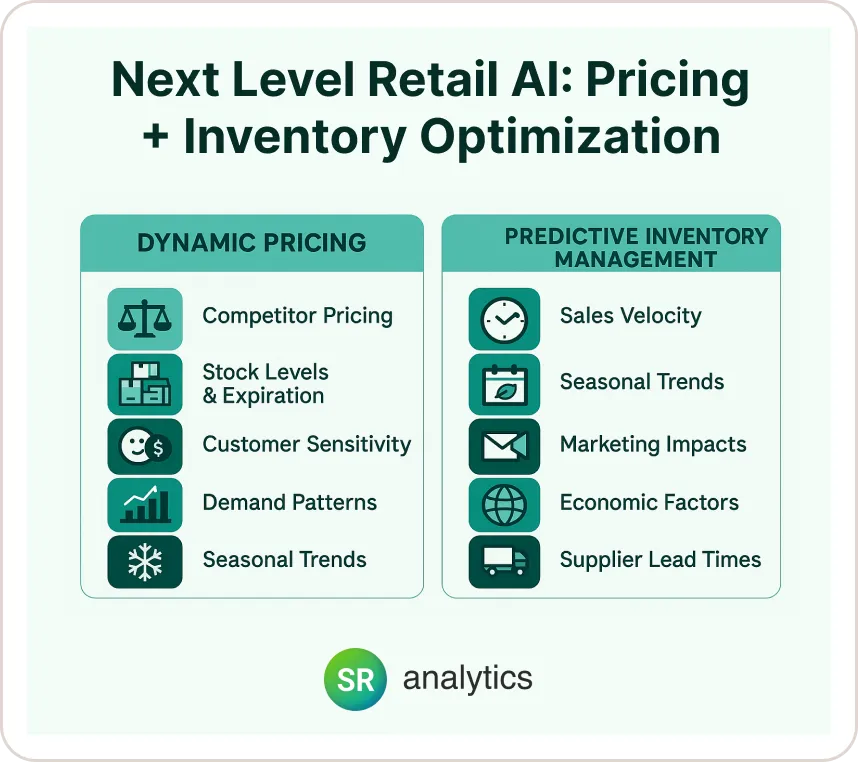
Dynamic Pricing That Responds to Market Conditions
Static pricing is becoming obsolete. AI in retail industry applications now enable dynamic pricing that adjusts in real-time based on demand, competition, inventory levels, and even customer behavior.
Here’s what I find fascinating: AI doesn’t just change prices—it optimizes them. The system considers factors like:
- Competitor pricing across multiple channels
- Inventory levels and expiration dates
- Customer price sensitivity
- Market demand patterns
- Seasonal trends
Real Example: Home Depot uses AI to adjust prices on over 100,000 items daily, resulting in improved margins and inventory turnover. This kind of sophisticated pricing strategy requires a robust data infrastructure that can process vast amounts of information in real-time.
Inventory Management That Prevents Problems Before They Happen
Traditional inventory management is reactive—you notice you’re out of stock when customers start complaining. AI-powered inventory management is predictive—it identifies potential stockouts weeks in advance.
Predictive Inventory Analytics consider:
- Sales velocity trends
- Seasonal patterns
- Marketing campaign impacts
- Economic indicators
- Supplier lead times
I’ve seen clients reduce holding costs by 20-30% while improving customer satisfaction through better product availability. The key is shifting from “what happened” to “what will happen”—the same principle behind effective KPI tracking.
Customer Service Revolution: AI That Actually Helps
Chatbots That Don’t Frustrate Your Customers
We’ve all dealt with terrible chatbots that can’t understand simple questions. Modern AI-powered customer service is different—it’s actually helpful.
Conversational AI in retail now handles:
- Complex product inquiries
- Order status updates
- Return processing
- Personalized recommendations
- Technical support
The key difference? These systems use natural language processing to understand context, not just keywords. They can handle follow-up questions and maintain conversation flow like a human agent.
In-Store AI That Enhances Human Service
AI isn’t replacing human retail workers—it’s making them more effective. Retail data analytics powers tools that help staff provide better service:
Clienteling Apps: Sales associates get real-time access to customer preferences, purchase history, and personalized recommendations.
Inventory Visibility: Staff can instantly check stock levels across all locations and arrange transfers or special orders.
Performance Analytics: Managers get insights into which products are selling, which staff members are most effective, and how to optimize store layouts.
This is the kind of integrated approach we help implement through our comprehensive BI consulting services, ensuring that technology enhances rather than replaces human expertise.
The Data Behind the Transformation
Turning Retail Data Into Competitive Advantage
Here’s something most retailers don’t realize: your data is probably your most valuable asset. But only if you know how to use it effectively.
Retail analytics powered by AI transforms raw data into actionable insights:
Customer Behavior Analysis: Understanding not just what customers buy, but when, why, and how they make purchasing decisions.
Market Trend Identification: Spotting emerging trends before they become mainstream, giving you a competitive advantage.
Operational Efficiency Metrics: Identifying bottlenecks and optimization opportunities across your entire operation.
Real-World Impact: Data-Driven Results
I’ve worked with retailers across different verticals, and the results consistently show that data-driven companies are 23 times more likely to acquire customers and 19 times more likely to remain profitable.
One client, a mid-sized fashion retailer, used AI analytics to optimize their product mix. By analyzing customer data and market trends—using techniques similar to those in our real-world analytics examples—they identified which styles were likely to be popular and adjusted their buying accordingly. The result? A 40% improvement in gross margins and a 25% reduction in markdown inventory.
The transformation didn’t happen overnight. It started with proper data cleaning and preparation and evolved into a comprehensive analytics strategy that touched every aspect of their business.
Overcoming Implementation Challenges

Common Obstacles and How to Address Them
Let’s be honest—implementing AI in retail isn’t always smooth. Here are the most common challenges I see and how to overcome them:
Data Quality Issues: Many retailers have data scattered across different systems with inconsistent formats. The solution? Start with a comprehensive data analytics audit and cleaning process before implementing AI solutions.
Staff Training and Adoption: New technology is only valuable if people use it. Invest in comprehensive training and change management from day one.
Integration Complexity: AI systems need to work with existing POS, inventory, and e-commerce platforms. Choose solutions that offer robust API integrations and work with experienced analytics consultants who understand retail-specific challenges.
ROI Measurement: Define clear metrics before implementation. Track not just revenue impact, but also operational efficiency gains and customer satisfaction improvements.
Starting Small, Scaling Smart
Here’s my advice for retailers considering AI: start with one specific use case, measure results, then expand. Don’t try to transform everything at once.
High-Impact Starting Points:
- Inventory forecasting for top-selling categories
- Email marketing personalization
- Customer segmentation for loyalty programs
- Dynamic pricing for seasonal items
Once you see results in one area, you can expand to more complex applications like supply chain optimization or omnichannel analytics. This approach mirrors the methodology we use in our retail analytics services, ensuring sustainable growth and measurable results.
The Future of Retail Analytics
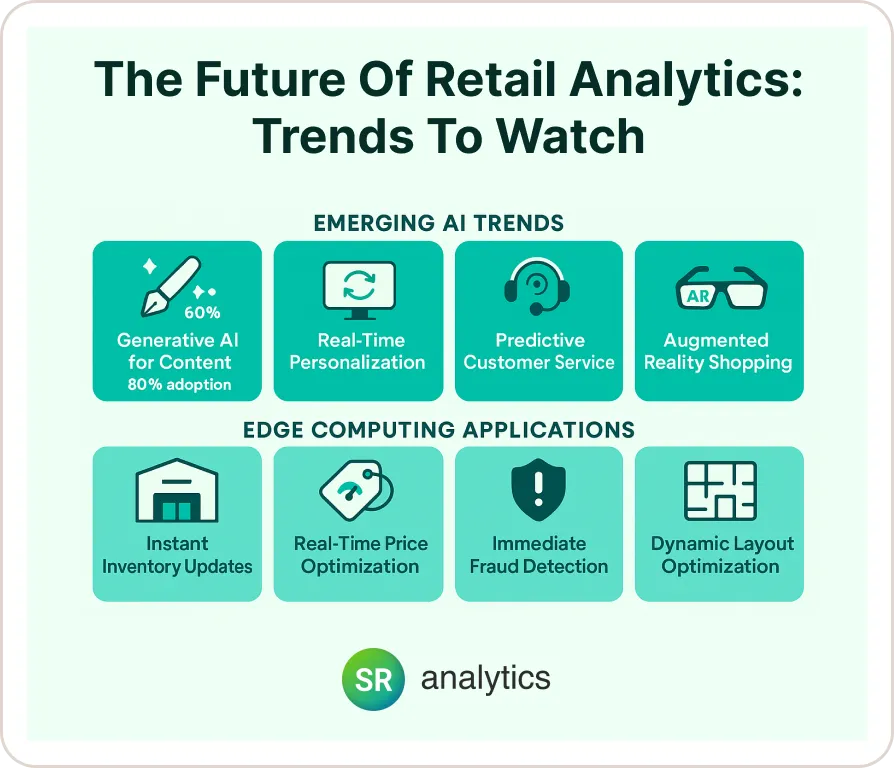
Emerging Trends to Watch
Generative AI for Content Creation: 60% of retailers are piloting generative AI for creating product descriptions, marketing copy, and social media content.
Real-Time Personalization: AI systems that adjust website content, product recommendations, and pricing in real-time based on individual customer behavior.
Predictive Customer Service: AI that identifies potential customer issues before they become problems, enabling proactive support.
Augmented Reality Shopping: Virtual try-on experiences and AR-powered product visualization that bridge online and offline shopping.
The Role of Edge Computing
Edge computing will bring AI processing closer to where data is generated—in stores, warehouses, and distribution centers. This enables real-time decision-making without relying on cloud connectivity.
Practical Applications:
- Instant inventory updates
- Real-time price optimization
- Immediate fraud detection
- Dynamic store layout optimization
The future of retail analytics lies in this seamless integration of AI, edge computing, and human expertise—creating systems that are both intelligent and intuitive.
Key Takeaways for Retail Leaders
After working with dozens of retail clients through our analytics consulting practice, here’s what I’ve learned about successful AI implementation:
Start with Business Problems, Not Technology: The most successful AI projects solve specific business challenges, not just implement cool technology.
Data Quality Is Foundation: AI is only as good as the data it’s trained on. Invest in proper data management and integration before implementing AI solutions.
Change Management Matters: Technology adoption is as much about people as it is about systems. Plan for training and cultural change.
Measure Everything: Define success metrics upfront and track progress continuously. ROI isn’t just about revenue—consider operational efficiency, customer satisfaction, and competitive advantage.
Think Ecosystem, Not Point Solutions: The most value comes from integrated AI systems that work together, not isolated tools.
Conclusion: Your Next Steps in the AI-Powered Retail Revolution
The AI in retail industry transformation isn’t coming—it’s here. Retailers who embrace data analytics in retail and predictive analytics today will have significant advantages over those who wait.
The evidence is overwhelming: companies using AI see measurable improvements in customer acquisition, operational efficiency, and profitability. From Amazon’s recommendation engines to Zara’s supply chain optimization, the most successful retailers are those who’ve learned to turn data into competitive advantage.
But here’s the crucial point: you don’t need to figure this out alone. The technology is complex, but the implementation doesn’t have to be overwhelming when you have the right partner and strategy.




